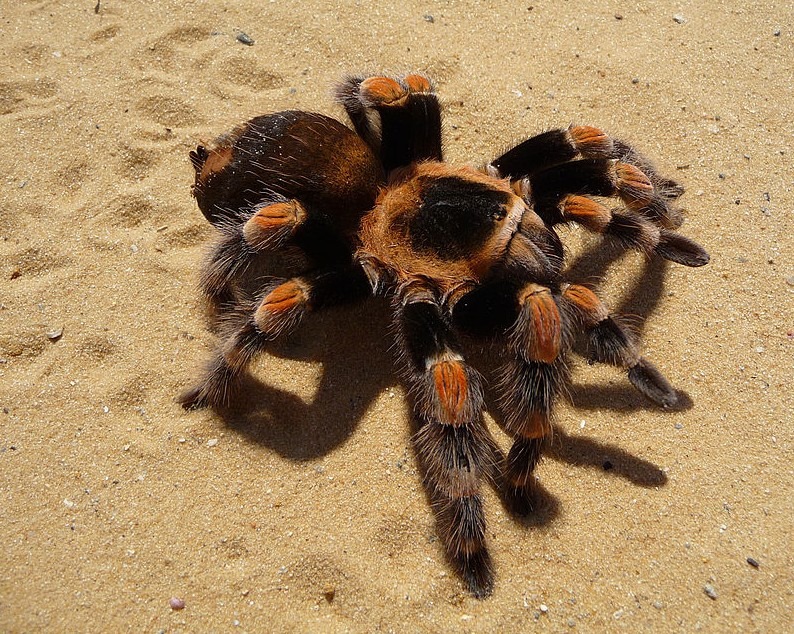The Mexican Red-Knee Tarantula, also known as Brachypelma smithi and Brachypelma hamorii, is often the first choice of many beginner spider enthusiasts because it is docile and easy to handle. Like many tarantulas, the Mexican Red-Knee Tarantula grows slowly. Mexican Red-Knee Tarantulas are famed for their bright red “knees” that create an excellent contrast with their dark body color, making them easily distinguishable from other tarantula species. If you want to find out more about this tarantula species, make sure to read further!
History
In the wild, Mexican Red-Knee Tarantulas take refuge in dry, arid areas with minimal vegetation, particularly in habitats such as scrublands, deserts, tropical deciduous forests, and dry thorn forests. They like living in rocky areas and burrows at the base of thorny vegetation such as cacti. Their burrows generally have a single entrance that is a little wider than the tarantula.
These tarantulas have eight eyes placed around their head, enabling them to look forward and backward. Despite having a wide range of sight, they have relatively poor eyesight. Their hairs on their legs are utilized to sense vibrations, while the palps situated at the tips of their legs allow them to feel, smell, and taste. Mexican Red-Knee Tarantulas have two claws, which enable them to climb slippery surfaces.
Characteristics of a Mexican Red-Knee Tarantula
Average life span: Females have 20 to 30 years, while males have 10 years
Average size: Leg length is around 5 inches
The Mexican Red-Knee Tarantula is a large, dark spider that has a black abdomen covered in brown hairs. Its legs have dark-orange, orange, or reddish joints, hence its name. Its carapace is creamy beige, which has a prominent black square. The cephalothorax has four pairs of legs and one pair of pedipalps.
Mexican Red-Knee Tarantulas belong to the most docile and calm tarantulas in the pet trade, making them perfect pets for beginners. They rarely bite, however, like other tarantulas, they eject urticating hairs from their abdomens and legs if threatened. These mildly toxic hairs are their defense mechanism against predators. In humans, these hairs may cause allergic reaction.
Caring for a Mexican Red-Knee Tarantula
A single Mexican Red-Knee Tarantula would require a 20-gallon tank, with a width that is twice to thrice wider than the leg span of the spider. The enclosure should be escape-proof—an enclosure with one side opening is recommended since this tarantula likes to hang upside down atop of the tank.
The substrate should be a mixture of soil, peat moss, and vermiculite, and should be at least 4 inches thick to accommodate your spider’s burrowing habits. Wood, clay flower pot, and cork bark can provide an excellent shelter or hiding spot for your Mexican Red-Knee Tarantula. Do not forget to design the enclosure with fake plants to mimic the spider’s natural habitat.
It is essential to maintain the ideal temperature and humidity for your spider. As such, the recommended enclosure temperature should fall between 75 and 80 degrees Fahrenheit, which can be achieved by situating a heat mat under one portion of the terrarium. Maintain the humidity level between 60 and 70 percent. Place a water bowl inside the enclosure to achieve the desired humidity instantly. If you see your spider pet hovering over the water bowl but not drinking water, it may be a sign that the environment is too arid. If your pet is continuously hiding in a corner of the terrarium, the environment may be too humid.
Feed your Mexican Red-Knee Tarantula with live crickets and other large insects such as cockroaches and locusts. In some cases, some pet owners raise and feed insects alongside the spider. Grasshoppers and large bugs can also be fed to your spider, but ensure that their diet must not include pesticide-laden plants. Small lizards and pinky mice could be occasionally fed as a protein boost, but keep in mind to clean the remains after. Remove uneaten food sources because their constant movement might stress your pet spider. Feed your pet once or twice a week.
A small shallow water dish is a drinking source, as well as help maintain the humidity of the enclosure. Regularly change your pet’s water supply. Mexican Red-Knee Tarantulas are prone to dehydration due to low humidity stress, so keep doing excellent husbandry practices to lower the risks of illnesses.

